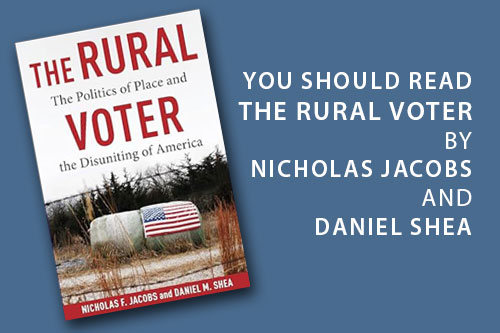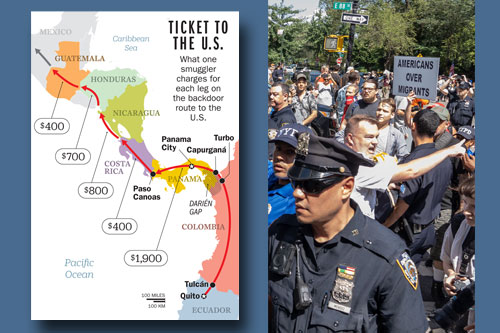The following article by Ruy Teixeira, senior fellow at the American Enterprise Institute, politics editor of The Liberal Patriot newsletter and author of major works of political analysis, is cross-posted from The Liberal Patriot:
The left isn’t dead yet. But it’s getting there.
That’s a shame because the self-identified left played a leading and productive role in the 20th century. The various socialists, social democrats, and radicals that made up this loose aggregation pushed unions and government policy that benefited the working class, helped tame the excesses of capitalism and provided the shock troops for efforts to end discrimination, ensure equal treatment for all, and protect the environment. On all these fronts, the left made important contributions.
But the left came into the 21st century beaten down. From the Reagan Revolution of the 1980s to the rise of the Third Way in the 1990’s to the first Bush term and War on Terror that started the century, it didn’t seem like anyone really wanted to hear from the left any more. Political contention between the parties and within American politics generally had passed the movement by.
And then: a sort of revival, sparked initially by the backlash to the Iraq war. The revival was strengthened by the Great Recession of 2008-09 and Obama’s historic first election, gathered force through his second term with the rise of Occupy Wall Street and Black Lives Matter, and then was turbocharged by Bernie Sanders’ insurgent candidacy and, of course, the norm-busting election of Donald Trump and his chaotic first term in office. Suddenly, being on the left was cool again. The moribund Democratic Socialists of America (DSA) spiked to 100,000 mostly young members from a few thousand aging veterans of the 20th century left.
And it wasn’t just the DSA. In many circles, a radical critique of American society as structurally racist, hostile to marginalized communities, and embedded in a rapacious capitalist system that will destroy the planet became a sort of conventional wisdom. In this view, opposing Trump had to be joined to a struggle against all these aspects of oppression (the “omnicause”) and to social transformation. Otherwise, the oppression would remain even if Trump himself was removed.
This view spread through sympathetic cultural milieus where it already had a considerable presence—universities, media, the arts, nonprofits, advocacy groups, foundations, and the infrastructure of the Democratic Party itself—redefining what it meant to be on the left. In opposing Trump, who was himself so radical, it seemed only reasonable to be radical in return.
As a result as the teens drew to close, punctuated by the COVID pandemic and the George Floyd summer of 2020, the left was both larger than it had been in a long time and very different from earlier iterations. This was a left that believed America was a white supremacist society, fully bought into climate catastrophism, prized “equity” above social order, good governance and equal opportunity and thought “no human being is illegal” was a good approach to immigration policy. And they were perfectly willing to shout you down if you didn’t believe all this stuff or even if you didn’t use the right language when referring to these issues. Not coincidentally this was also a left with almost no connection to the working class, in stark contrast to the 20th century left’s origin story.
But this left did have quite a lot of influence on Biden administration staffing and policies, down to the language officials used to describe their initiatives. To their shock, however, American voters were not delighted with the results, especially the working class, and the left’s preferred party, the Democrats, are out on their ear.
So this would be a great time for the left to recalibrate its approach, right? But are they? To paraphrase George W. Bush: “Is our leftists learning?”
Sadly, that does not appear to be the case. Neither in the evolving intraparty strategic debate after the November election nor in reactions to GOP priorities and Trump’s executive orders is there much evidence of a desire for compromise on the part of the left. Instead, there are signals that there are hills—many hills!—they are willing to die on rather than give ground. Here are three of the most important hills they are willing to die on—and probably will.
1. Immigration/border security/deportations. Outside of the economy, no issue hurt the Democrats more in 2024 than immigration. And the laxness on border security and quasi-open borders policy that resulted in massive waves of illegal immigration was very much a priority and product of the left. You’d think they’d be rushing to correct that mistake. Nah.
Take the Laken Riley Act which just passed Congress. Laken Riley was the Georgia nursing student who was murdered by illegal Venezuelan immigrant Jose Ibarra (recall that Biden, under pressure from the left, apologized for referring to illegal immigrant Ibarra as “illegal” as opposed to the approved nomenclature of “undocumented”). The legislation named after her provides for the detention of illegal immigrants charged with theft-related crimes, assault on a police office or acts causing death or bodily harm to an individual. Just 12 Democrats in the Senate and 46 Democrats in the House were willing to vote for the Laken Riley Act, with the left, heavily concentrated in blue states, conspicuous by its absence.
Outside of Congress, left reaction was predictable and vitriolic. Sarah Dohl, chief campaigns officer of the movement organizing group Indivisible had this to say:
Spineless. That’s the only word for the..Senate Democrats who handed MAGA Republicans a gift they didn’t deserve…The Laken Riley Act is a racist, xenophobic attack on immigrants that shreds constitutional rights and hands power to extremists like [Texas attorney general] Ken Paxton to hijack federal immigration policy. It’s not just cruel—it’s a train wreck of chaos and bad faith. And yet, Senate Democrats caved.
And that’s just the Laken Riley Act! That Act is merely the opener for a variety of Trump administration moves to drastically tighten up border security and deport many of the illegal immigrants who are currently here, focusing initially on those with criminal records. The left will oppose all these moves, with appropriately inflammatory rhetoric, despite their general popularity. Indeed, deporting those illegals with criminal records is stunningly popular; a new New York Times poll finds 87 percent overall support for deporting such illegal immigrants including overwhelming support among surprising groups like Democrats (83 percent) and Hispanics (85 percent).
The simple fact of the matter is that it is impossible to solve the illegal immigration problem without changing the incentive structure for prospective immigrants by: (a) making it much tougher to enter the U.S. illegally, and (b) making it much tougher to stay in the country once you are here illegally. The public understands this while the left evidently does not or (more plausibly) just does not want to solve the problem. They are determined to die on this hill and die they will, perhaps dragging the rest of the Democratic Party down with them.
2. Identity politics/equity/”trans rights.” The contemporary left is deeply invested in these issues and shows little sign of backing down or compromising on any of them. Take the statement of Ben Wikler, the left’s favorite candidate for chair of the Democratic National Committee:
We unite our coalition by making sure everyone’s at the table.
As DNC Chair our leadership team will lift up our full coalition—Blacks, Latino, Native, AANHPI, LGBTQ. Youth, Interfaith, Ethnic, Rural, Veteran and Disability representation.
This does not seem like the statement of someone even willing to entertain the idea that identity politics is past its sell-by date. Or consider that it is Trump, not anyone on the left, who ringingly called for unrestricted free speech and for a society that is “colorblind and merit-based.” That’s because all these principles have become right-coded in the last period of time and are therefore verboten for anyone on the left to endorse. That’s crazy! As Jeff Maurermemorably puts it, these statements by Trump
hurt not because I disagree, but because I can’t believe that the left has fucked things up so badly that free speech, color blindness, and meritocracy are now issues that the right feels they own. In fact, those issues are so right-coded that they made the list of Things To Throw In Democrats’ Faces At The Inauguration Speech. A little more than a decade ago, those were bedrock liberal ideals. How did we screw this up?
That wasn’t the only challenge in Trump’s inauguration speech to left shibboleths and there are even more in his spate of executive orders. The left is inclined to fight each and every one of them because they believe history is on their side. But is it? I am doubtful the median working-class voter is going to greet the demise of DEI programs in their workplace, public institutions, or community with anything but delight.
Nor will they miss the pronoun police, the insistence that trans-identified biological boys should be able to play girls sports or the easy availability of “gender-affirming care” (e.g., puberty blockers, hormones, surgery) for minors. The Times poll mentioned earlier found that 80 percent of working-class (non-college) respondents opposed transgender birth males playing in women’s sports and 75 percent opposed allowing puberty blockers and hormone therapy to be prescribed for anyone under 18.
For all that, only two (2!) House Democrats—both conservative Hispanic Democrats from Texas—could find the wherewithal to vote for The Protection of Women and Girls in Sports Act which would prohibit the participation of biological men and boys in women’s and girls sports. Even Massachusetts Democratic representative Seth Moulton, who had raised questions about having biological boys in girls sports, did not vote for the bill presumably because of pressure from the left (they viciously attacked him for being a “Nazi”, transphobe, etc, etc.)
The left is determined to die on this hill and is willing to call out their army of enforcers to defend it. But the clear shift in public sentiment against their agenda makes defeat far more likely than victory here. Meanwhile, Democrats’ ability to adapt and move to the center on these issues will be seriously compromised while the left is busy dying on that hill.
3. Climate catastrophism/renewables uber alles/net zero. Trump has thrown down the gauntlet to the left on climate and energy issues. In his speech and in his executive orders he has made clear his intention to untether domestic energy production from regulatory and permitting obstacles and de-emphasize Biden administration policies centered around renewables and electric vehicles. He promises energy abundance and low energy prices. The left hates this but the fact of the matter is that such an approach is far closer to what the public wants—especially what the working class wants—than the left’s quasi-religious commitment to a rapid renewables-based clean energy transition.
This can be easily seen by reviewing public opinion data on climate and energy issues. Here’s a refresher:
A recent YouGov survey designed by myself and Roger Pielke found that, by 74 percent to 26 percent, working-class voters prefer an energy approach that uses a mix of energy sources including oil, coal, and natural gas along with renewables to an approach that seeks to phase out the use of oil, coal, and natural gas completely.
In terms of the energy they consume, cost and reliability are way, way more important to working-class voters than possible effects on the climate. Given four choices, 41 percent of these voters said the cost of the energy they use was most important to them and 35 percent said the availability of power when they need it was most important. Just 17 percent thought the effect on climate of their energy consumption was most important and 6 percent selected the effect on U.S. energy security.
In terms of proposals to mitigate the effects of climate change, getting to “net zero” as quickly as possible is relatively unimportant to working-class voters. Asked to consider proposals to reduce the effects of global climate change, these voters were least likely to say “getting the U.S. to net zero carbon emissions as quickly as possible” was very important to them personally (26 percent), fewer than said “limiting the burden of regulations on business” was very important (33 percent). Working-class voters were most likely by far to say keeping consumer costs low (66 percent) and increasing jobs and economic growth (60 percent) were very important aspects of climate mitigation proposals.
Consistent with many other surveys, the YouGov survey found that climate change as an issue has very low salience to working-class voters. Voters were asked to evaluate a list of 18 issue areas and rate their priority for the president and Congress to address in the coming year. As a “top priority,” dealing with global climate change ranked 16th out of these 18 areas among working-class voters, well behind strengthening the national economy, fighting inflation, defending the country from terrorist attacks, and keeping Social Security financially sound—and also behind reducing health care costs, dealing with immigration, improving the educational system, keeping energy costs low, reducing the budget deficit, reducing crime, improving how the political system works, improving the job situation, strengthening the military, dealing with the problems of poor people, and dealing with drug addiction. The climate issue only ranked above global trade and issues around race.
Finally, by 30 points (59 to 29 percent) working-class voters flat-out favor more domestic production of fossil fuels like oil and gas. But only 15 percent of these voters are aware that the Biden administration increased oil production on federal lands. However, when informed that the U.S. has, in fact, increased domestic production of oil and gas in the last several years, they are delighted. Almost three-quarters (73 percent) of working-class voters said “this is a positive development, which brings good jobs for U.S. workers, ensures our energy supply and helps the U.S. support our allies who need similar resources” compared to 27 percent who thought “this is a negative development, which brings more pollution, climate change, and continued reliance on fossil fuels.”
In short, Trump is likely to shore up his base, rather than lose support, with his energy proposals. Meanwhile, the usual suspects on the left have already denounced his moves as undercutting the sacred quest to stop climate change, lining the pockets of evil fossil fuel companies and even (somehow) raising grocery prices. This hill, too, is evidently one they are willing to die on rather than compromise in any way on what is likely to be an extremely popular quest for energy abundance. And here too the left is likely to be decisively defeated as they expend vast amounts of money and effort defending the indefensible and kneecapping the ability of their party to come up with an alternative that can actually compete with Trump and his party.
Such is the nature of today’s left—divorced from the working class but intimately connected to the leftist strongholds of the professional class. The latter connection has kept them blissfully unaware of how far outside of the public opinion mainstream their current commitments are and therefore how quickly the hills they are defending could be overrun. That’s happening right now but the left seems determined to fight on to the bitter end.
So be it. Perhaps out of the ashes of this left, a better 21st century left may arise that channels the best aspects and universal principles of the 20th century left. But in the meantime, Democrats would be well-advised to craft an approach that ignores the left as much as possible. Just because the left is willing to die on all their various hills doesn’t mean Democrats have to as well.








